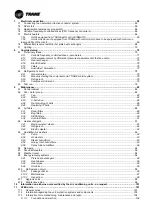
Example above:
15 → 15 x 100 = 1500
152.5 mm x 10 =
1525 mm = clear width supply air
(in this example also for exhaust air)
6 → 6x100 = 600
152.5 mm x 4 =
610mm = clear height supply air
(in this
example also for exhaust air)
1.2 Intended use / foreseeable misuse
1.2.1 Intended use
An AHU is used, depending on the chosen model, to create a desired indoor air quality. Parame-
ters are…
-
air change
-
air temperature and humidity
-
to filter normal contaminated air
-
in special cases for filtering air for clean room applications
The units are
suitable for…
-
an ambient air temperature range of -20°C to +70°C and for the supplied air from -20°C to
+40°C
-
normal air
-
for the operation within the agreed technical data
Operation at other conditions must be agreed in writing.
If products and components of other manufacturers are used, these must be recommended or ap-
proved by TRANE.
On-site changes are in full safety responsibility of the operator.
1.2.2 Foreseeable misuse
Other than above use, is considered as improper and must be excluded totally:
-
The commissioning of equipment, prior performing the steps indicated in the assembly instruc-
tions and operating with an open fan unit door is a serious security risk.
-
Opening the unit, without securing the repair switch in the off position, represents a massive
security risk.
-
The operation of an AHU equipped with electric heater while fan-motor is cut off, or if fan is
working at a limited airflow for example caused by closed dampers or similar, but with electric
heater in operation produces an imminent fire risk.
-
The operation in an explosive atmosphere is prohibited, as long as the AHU is not executed in
accordance with the ATEX directive. Application of ATEX units, see
chapter 11 (ATEX units)
.
-
Handling of air with corrosive / aggressive components.
1.3 Modular design
Because of the modular AHU design, the manual covers all the possible sections and components
which can be delivered. The ordered range is smaller and can be seen on the technical data sheet
- see
chapter 1.4 (Documentation
.

































